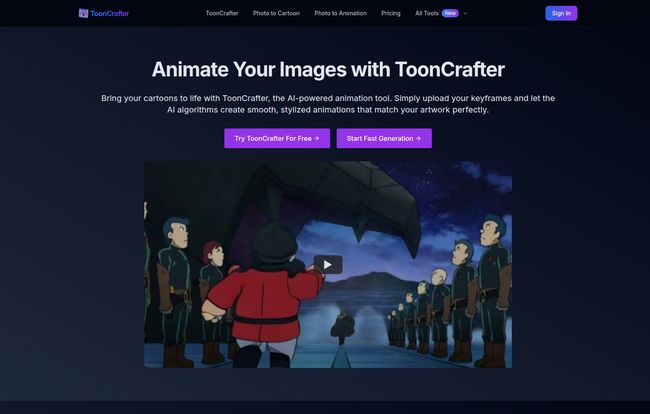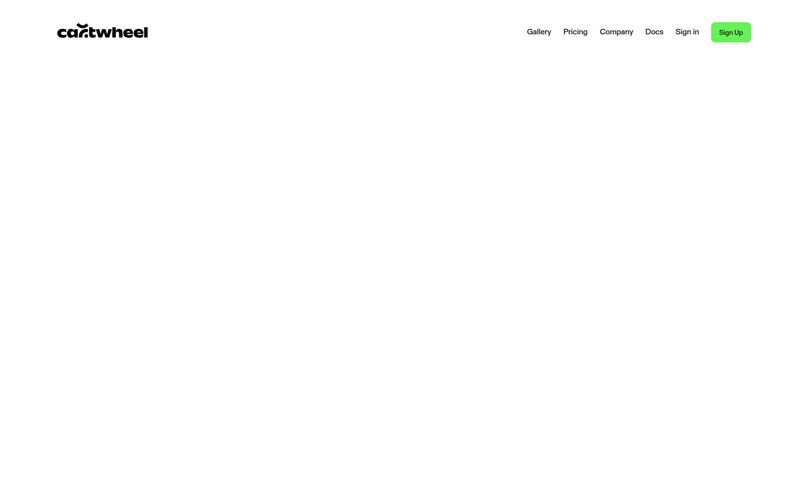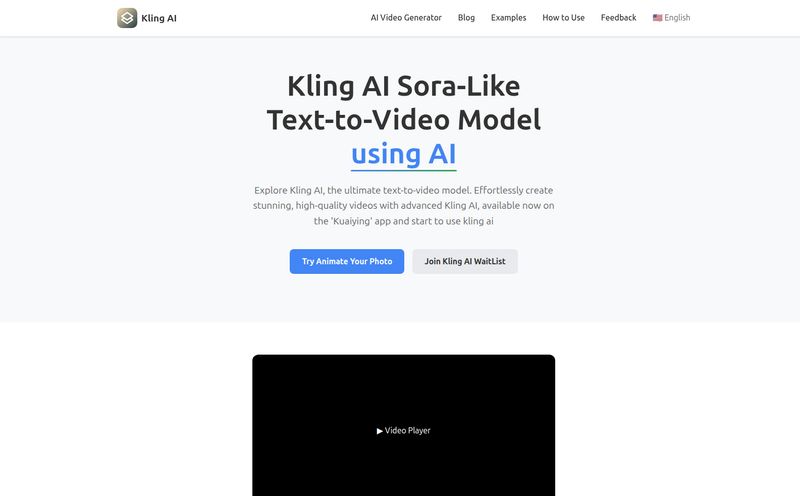For years, I've been watching the AI space with a mix of excitement and, frankly, a bit of dread. As someone who lives and breathes digital content, you see these tools promising to change everything overnight. Some are revolutionary. Others are… well, let's just say they’re more hype than substance. So when I heard about ToonCrafter, an AI tool that claims to animate your cartoons, my curiosity was definitely piqued.
My adventure, however, started with a bit of a fumble. My first attempt to find the tool led me to a dead end—a classic "This site can't be reached" page. It felt like a very on-brand start for exploring a new, slightly mysterious piece of tech. A quick search later, I found the real home of ToonCrafter, and I was ready to see if it could live up to its own promises.
So, What is ToonCrafter, Really?
Let's get one thing straight right away: this is not another one of those text-to-video generators that spits out vaguely cinematic, often bizarre video clips. ToonCrafter is something different, something more focused. Think of it less as a director and more as a digital 'in-betweener'.
For anyone who's ever dabbled in animation, you know the grind of creating 'in-between' frames. You draw your key poses—the start and end of a motion—and then you have to painstakingly draw all the little frames that connect them to create smooth movement. It's tedious work. ToonCrafter aims to take that tedious part off your plate. You give it your keyframe drawings, and its AI generates the transitional frames, creating a fluid animation that, and this is the important part, supposedly matches your unique art style. A bold claim.

Visit ToonCrafter
The Core Features Under the Hood
ToonCrafter isn't just pulling random frames out of thin air. It's built on some pretty specific tech that's worth looking at. It’s not magic, it’s algorithms. But sometimes good algorithms feel like magic, right?
Style-Preserving Animation
The absolute centerpiece of this tool is its ability to learn from your art. They call it Style Transfer Learning. Instead of forcing a generic 'cartoon' style onto your work, it analyzes the line work, color palette, and textures of the keyframes you provide. It's like a style chameleon. This is a massive point in its favor because the last thing any artist wants is for an AI to strip away their signature look. It promises to maintain the soul of the original artwork, which is where so many other AI tools fall flat on their face.
Smooth Transitions and Pixel Details
The whole point is smooth animation, and the tool uses what it calls Pixel-Level Detail Extraction to make it happen. It looks at your images on a deep level to generate transitions that feel natural rather than janky or robotic. The goal is to create something that looks like it was animated by a human hand, not a script. A noble goal, for sure. We've all seen those jittery AI animations on social media; ToonCrafter is trying to be a cut above that.
The Good, The Bad, and The Kinda Blurry
After playing around with it, uploading a few simple character poses to see what it would spit out, I've got some thoughts. No tool is perfect, especially not in the AI world. So here’s the breakdown of my experience.
What I Genuinely Liked
First off, the interface is clean. It's user-friendly, and you don’t need a degree in computer science to figure out how to upload your images and get started. That's a huge plus. For paid users, the speed is also pretty impressive. Getting a short animated clip in around 20 seconds feels like some kind of dark magic. It's fast enough that you can experiment without feeling like you're wasting your entire afternoon.
But the real winner for me is the style preservation. It actually works. The animations it produced for me retained the feel of my original (and admittedly simple) drawings. The lines had a similar weight, and the colors didn't get muddy. It felt like my drawing was moving, which was a genuinely cool moment.
Where It Stumbles a Bit
Now for the reality check. The biggest, most glaring limitation is the resolution. All animations are capped at 512x512 pixels. Let's be real: that's small. It's perfectly fine for a quick social media GIF, a Discord emoji, or maybe a storyboard preview. But you're not creating your next 4K animated short with this. Not yet, anyway. For any professional-grade work, this is a significant hurdle.
I also noticed what the developers politely call a need for “improvement in detail processing.” In practice, this means that very intricate designs or subtle facial expressions can get a bit lost or smudged in the final animation. It handles broad movements well, but the tiny, nuanced details can be a bit of a gamble. And of course, the free plan is slow. It works, but you'll be waiting a bit, which is fair enough for a free service.
Let's Talk Money: ToonCrafter's Pricing Plans
The platform runs on a freemium model, which I always appreciate. You can dip your toes in the water without pulling out your wallet. But if you want to get serious, you’ll need to pony up. The plans seem geared toward different levels of usage.
| Plan | Price (Billed Annually) | Best For |
|---|---|---|
| Free Plan | $0 / month | Curious hobbyists, testing the waters. |
| Basic Plan | $7.90 / month | Regular users, indie creators. |
| Plus Plan | $15.90 / month | Frequent animators, social media managers. |
| Pro Plan | $23.90 / month | Power users, small studios. |
| Max Plan | $34.90 / month | Heavy-duty commercial use. |
Note: These prices reflect the annual billing discount. Monthly options are available but cost a bit more.
Is it worth it? I think for an indie creator who needs to quickly mock up animations for a project or produce a bunch of simple social content, the Basic or Plus plan could absolutely be worth the investment. It could save hours of tedious work, and time is money.
Who Should Actually Use ToonCrafter?
This is the bottom line, isn't it? This tool isn't for everyone. If you're a big animation studio like Pixar, you're obviously not going to fire your animation team and switch to a 512x512px web tool. But you're not Pixar.
ToonCrafter is for the little guy. It’s for the indie game developer who needs to animate a character sprite. It’s for the social media manager who wants to bring their brand's mascot to life without a huge budget. It's for the comic artist who wants to create cool animated panels to promote their work. It's a fantastic tool for storyboarding and creating animatics quickly.
It empowers individual creators to add a layer of dynamic movement to their work that was previously too time-consuming or expensive to consider. It’s a democratization of a small, but important, part of the animation process.
My Final Take on ToonCrafter
So, is ToonCrafter a game-changer? Maybe. It depends on the game you're playing. It’s not going to replace skilled animators, nor should it. What it does do is offer a powerful assist. It's an intelligent tool that can handle the grunt work, freeing up artists to focus on what really matters: character design, key poses, and storytelling.
Despite its current limitations, like the resolution cap, I’m genuinely optimistic. This feels like a step in the right direction for AI—a tool designed to collaborate with an artist, not replace them. It’s a clever little apprentice that’s only going to get better with time. If you're a creator in the cartooning space, I'd say give the free plan a spin. You might be surprised at how useful it is.
Frequently Asked Questions
Is ToonCrafter free to use?
Yes, ToonCrafter offers a free plan! It comes with some limitations, like slower generation speeds and reduced features compared to the paid tiers, but it's a great way to try the tool out.
What is the maximum resolution for the animations?
Currently, the maximum output resolution for animations created with ToonCrafter is 512x512 pixels. This is suitable for web content and previews but not for high-definition video production.
How does ToonCrafter maintain my art style?
The tool uses a form of AI called Style Transfer Learning. It analyzes the keyframes you upload—looking at your line quality, colors, and overall aesthetic—and then applies that same style to the new, in-between frames it generates.
Can I use ToonCrafter for professional commercial projects?
You can, especially with the paid plans. However, you need to be mindful of the 512x512 resolution limit. It's best suited for projects where high resolution isn't a primary requirement, such as social media content, animated web elements, or storyboards.
How long does it take to generate an animation?
For users on the paid plans, generation is quite fast, typically taking around 20 seconds. Users on the free plan will experience slower generation times.
Is ToonCrafter difficult for beginners to use?
Not at all. One of its main strengths is a very user-friendly and intuitive interface. If you can upload an image to a website, you can use ToonCrafter. It's designed to be accessible for both beginners and professionals.
Reference and Sources
- ToonCrafter Official Website & Pricing
- "ToonCrafter: Generative Cartoon Interpolation" - The research paper behind the technology (for the super nerds out there).


